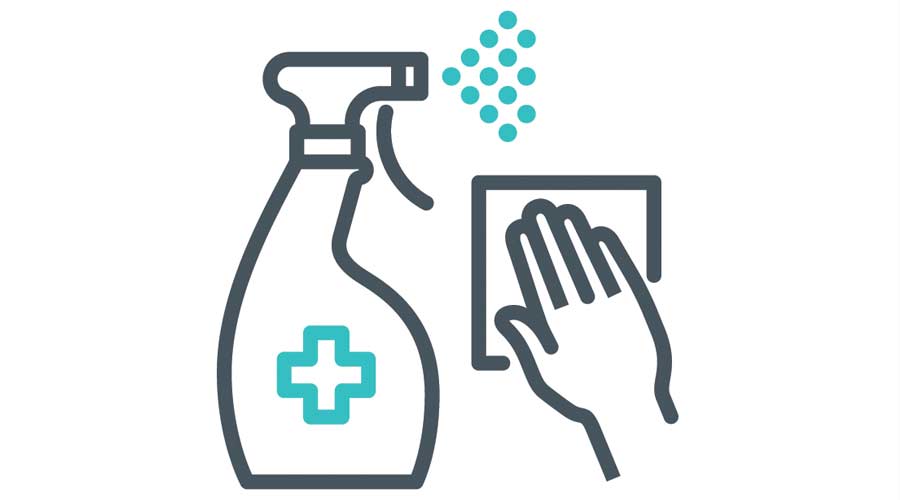
Quaternary Ammonium Compounds (Quats) have long been a mainstay in the arsenal of professional cleaners. These chemicals boast potent disinfecting properties, making them effective against a wide range of bacteria, viruses, and fungi. However, in recent years, quats have become a magnet for controversy, raising concerns about their safety and environmental impact. Building service contractors (BSCs) should understand the complexities surrounding quats — exploring their effectiveness, challenges, and potential alternatives within the professional commercial cleaning industry.
Quats will likely continue to be a complex issue within the commercial cleaning industry as the science grows and is explored over the coming years.
The core principle is fairly straightforward; quats work by disrupting the cell membranes of microbes. They essentially act like microscopic soap, dissolving the outer layer of the germ, causing it to leak its contents and eventually die off. This makes quats effective for disinfecting surfaces and preventing the spread of pathogens, particularly in high-risk environments such as hospitals and foodservice facilities.
Challenges and Concerns
Despite their effectiveness, quats present several challenges. One major concern is the growing threat of antimicrobial resistance. The overuse and misuse of quats can lead to the evolution of superbugs (microbes resistant to disinfectants), which poses a significant public health risk.
Threats like this are why Benjamin Tanner, the president and CEO of Round Rock, Texas-based Microchem Laboratory, founded the lab — to fill an apparent void in the marketplace and provide a reliable, dedicated space for the testing of disinfectants, sanitizers, antimicrobial devices, medical devices, and more. In simpler terms, the lab tests how efficient and effective cleaning products — such as quats — can be, while monitoring for safety.
Dr. Charles Gerba, a microbiologist from the University of Arizona, is also focused on gauging the performance and safety of quat-based cleaners. In a recent study, he and his team used bacteriophage MS-2 (a microorganism which is similar to norovirus but harmless to humans), to simulate the spread of potential infectious diseases in an office environment. Once in place, half of the employees were instructed to use disinfecting wipes containing quats on commonly touched surfaces at least once daily and employ proper hand hygiene. The virus was reduced by 80 to 99 percent with a 90 percent drop of viruses on hands or surfaces.
“The results show that viral contamination of [surfaces] in facilities occurs quickly, and that a simple intervention can greatly help to reduce exposure to viruses,” Dr. Gerba states. Quats can be a useful tool when it comes to halting potential problems before they take root.
Although these chemicals can be effective when used properly, an issue of concern is the environmental impact of quats. These chemicals may not or cannot break down easily in wastewater treatment systems, potentially harming aquatic life and disrupting ecosystems. Additionally, some studies suggest potential health risks associated with long-term exposure to quats — particularly for cleaning professionals who use them frequently.
Patricia Hunt earned the nickname “The Accidental Toxicologist” when a study she was conducting on the effects of quat-related compounds on mouse development changed venues. A change in cleaning routines in the lab was to blame for reduced fertility in her subjects — one facility used quat-based cleaners, the other didn’t.
Terry Hrubec, studying mice and their development at Virginia Tech, picked up on the same trend during her research. She connected the dots to potential dangers when noticing the similarities in Hunt’s study with her own experience asking about chemicals used to clean labs.
“If it’s causing a problem in mice, there’s a good chance it could cause a problem in humans,” Hrubec says.
Overall, the safety of quats remains a subject of debate. Regulatory agencies like the Environmental Protection Agency (EPA) have generally considered them safe for use when following manufacturer-recommended guidelines. However, concerns persist, particularly regarding potential respiratory issues and skin irritation for people with frequent exposure.
The question remains, can frontline cleaning crews achieve disinfection without quats? The good news is that the search for safer and more sustainable alternatives to quats is ongoing. Some promising approaches include the incorporation of natural antimicrobials, wherein certain plant-based oils (like tea tree oil and thymol) possess natural disinfectant properties, making them a safer approach and one that perhaps has more appeal to a green-minded user. While they’re not as broad-spectrum as quats, they do and can offer an eco-friendlier option for specific applications.
Similarly, ultraviolet (UV) light technology has been experimented with as of late. It is known that high-intensity UV light can effectively kill bacteria and viruses on surfaces without leaving any chemical residue, which has some appeal for those seeking a quat alternative.
While quats are unlikely to disappear entirely from the cleaning industry anytime soon, their future will likely involve a more responsible approach. There are several potential scenarios:
- Stricter Regulations: Regulatory bodies may introduce stricter guidelines on the use and disposal of quat-based cleaning products.
- Targeted Disinfection: Professionals might favor a targeted approach, using quats only in high-risk situations while opting for safer alternatives for routine disinfecting tasks.
- Innovation in Quat Technology: Advancements in quat formulations might lead to the development of more environmentally friendly and less persistent versions of these chemicals.
Tips and Tricks for Using Quat-based Cleaners Safely

 The Down and Dirty on Cleaning in Virus Season
The Down and Dirty on Cleaning in Virus Season How Surfactant Use is Expanding in Commercial Cleaning
How Surfactant Use is Expanding in Commercial Cleaning Maximize Your Margins: Learn How to Automate Pricing and Track Rebates
Maximize Your Margins: Learn How to Automate Pricing and Track Rebates